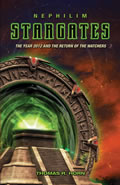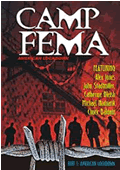PART 2
By Thomas R. Horn
June 10, 2014
NewsWithViews.com
The Lucifer Effect
Perhaps unknown to some readers is a most notorious experiment that took place in America more than forty years ago.
Commonly
referred to today as “The Stanford Prison Experiment,”
in 1971, a group of student recruits participated in a study at Stanford
University, where they were instructed to act out roles of detainees
and guards in a makeshift  prison
in the basement of the school. What resulted in the test was an unexpected
and almost immediate breakdown in normative social behavior that illustrated
such astonishing cruelty on the part of the participants that it was
quickly shut down, leading the organizer and director, Professor Philip
Zimbardo, to embark on a larger quest of discovery regarding how “the
majority of us can be seduced into behaving in ways totally atypical
of what we believe we are.”[1]
The program graphically illustrated that, given the right set of circumstances,
a majority of people are capable of monstrous inhumanity against others.
The Wikipedia entry on the Stanford Prison Experiment explains what
happened:
prison
in the basement of the school. What resulted in the test was an unexpected
and almost immediate breakdown in normative social behavior that illustrated
such astonishing cruelty on the part of the participants that it was
quickly shut down, leading the organizer and director, Professor Philip
Zimbardo, to embark on a larger quest of discovery regarding how “the
majority of us can be seduced into behaving in ways totally atypical
of what we believe we are.”[1]
The program graphically illustrated that, given the right set of circumstances,
a majority of people are capable of monstrous inhumanity against others.
The Wikipedia entry on the Stanford Prison Experiment explains what
happened:
Participants were recruited and told they would participate in a two-week prison simulation. Out of 70 respondents, Zimbardo and his team selected the 24 males whom they deemed to be the most psychologically stable and healthy. These participants were predominantly white and middle-class. The group was intentionally selected to exclude those with criminal background, psychological impairments or medical problems. They all agreed to participate in a 7–14-day period and received $15 per day (roughly equivalent to $85 in 2012).
The experiment was conducted in the basement of Jordan Hall (Stanford’s psychology building). Twelve of the twenty-four participants were assigned the role of prisoner (nine plus three alternates), while the other twelve were assigned the role of guard (also nine plus three alternates). Zimbardo took on the role of the superintendent, and an undergraduate research assistant the role of the warden. Zimbardo designed the experiment in order to induce disorientation, depersonalization and deindividualization in the participants.
The researchers held an orientation session for guards the day before the experiment, during which they instructed them not to physically harm the prisoners. In the footage of the study, Zimbardo can be seen talking to the guards: “You can create in the prisoners feelings of boredom, a sense of fear to some degree, you can create a notion of arbitrariness that their life is totally controlled by us, by the system, you, me, and they’ll have no privacy.…We’re going to take away their individuality in various ways. In general what all this leads to is a sense of powerlessness. That is, in this situation we’ll have all the power and they’ll have none.”
The researchers provided the guards with wooden batons to establish their status, clothing similar to that of an actual prison guard (khaki shirt and pants from a local military surplus store), and mirrored sunglasses to prevent eye contact. Prisoners wore uncomfortable ill-fitting smocks and stocking caps, as well as a chain around one ankle. Guards were instructed to call prisoners by their assigned numbers, sewn on their uniforms, instead of by name.
The prisoners were arrested at their homes and charged with armed robbery. The local Palo Alto police department assisted Zimbardo with the arrests and conducted full booking procedures on the prisoners, which included fingerprinting and taking mug shots. They were transported to the mock prison from the police station, where they were strip searched and given their new identities.
The small mock prison cells were set up to hold three prisoners each. There was a small space for the prison yard, solitary confinement, and a bigger room across from the prisoners for the guards and warden. The prisoners were to stay in their cells all day and night until the end of the study. The guards worked in teams of three for eight-hour shifts. The guards did not have to stay on site after their shift.
After a relatively uneventful first day, on the second day the prisoners in Cell 1 blockaded their cell door with their beds and took off their stocking caps, refusing to come out or follow the guards’ instructions. Guards from other shifts volunteered to work extra hours to assist in subduing the revolt, and subsequently attacked the prisoners with fire extinguishers without being supervised by the research staff. Finding that handling nine cell mates with only three guards per shift was challenging, one of the guards suggested that they use psychological tactics to control them. They set up a “privilege cell” in which prisoners who were not involved in the riot were treated with special rewards, such as higher quality meals. The “privileged” inmates chose not to eat the meal in order to stay uniform with their fellow prisoners. After only 36 hours, one prisoner began to act “crazy,” as Zimbardo described: “#8612 then began to act crazy, to scream, to curse, to go into a rage that seemed out of control. It took quite a while before we became convinced that he was really suffering and that we had to release him.”
Guards forced the prisoners to repeat their assigned numbers to reinforce the idea that this was their new identity. Guards soon used these prisoner counts to harass the prisoners, using physical punishment such as protracted exercise for errors in the prisoner count. Sanitary conditions declined rapidly, exacerbated by the guards’ refusal to allow some prisoners to urinate or defecate anywhere but in a bucket placed in their cell. As punishment, the guards would not let the prisoners empty the sanitation bucket. Mattresses were a valued item in the prison, so the guards would punish prisoners by removing their mattresses, leaving them to sleep on concrete. Some prisoners were forced to be naked as a method of degradation. Several guards became increasingly cruel as the experiment continued; experimenters reported that approximately one-third of the guards exhibited genuine sadistic tendencies [doing things we will not publish here]. Most of the guards were upset when the experiment concluded after only six days….
Zimbardo argued that the prisoners had internalized their roles, since, even though some had stated that they would accept “parole” even if it would mean forfeiting their pay, they did not quit when their parole applications were all denied. Zimbardo argued they had no reason for continued participation in the experiment after having lost all monetary compensation, yet they did, because they had internalized the prisoner identity.
Prisoner No. 416, a newly admitted stand-by prisoner, expressed concern over the treatment of the other prisoners. The guards responded with more abuse. When he refused to eat his sausages, saying he was on a hunger strike, guards confined him to “solitary confinement,” a dark closet: “The guards then instructed the other prisoners to repeatedly punch on the door while shouting at 416.” The guards stated that he would be released from solitary confinement only if the prisoners gave up their blankets and slept on their bare mattresses, which all but one refused to do.
Zimbardo
aborted the experiment early when Christina Maslach, a graduate student
in psychology whom he was dating (and later married), objected to
the conditions of the prison after she was introduced to the experiment
to conduct interviews. Zimbardo noted that, of more than fifty people
who had observed the experiment, Maslach was the only one who questioned
its morality. After only six days of a planned two weeks’ duration,
the Stanford prison  experiment
was discontinued.[2]
experiment
was discontinued.[2]
Following the Stanford Prison Experiment, Zimbardo wanted to continue his research into the dark side of human psychology to decipher under what conditions “it” can be uncaged. His next big opportunity came a decade ago, in April 2004, while on a business trip to Washington, DC. That’s when he saw the American television show 60 Minutes airing images taken from the Abu Ghraib prison in Iraq of naked detainees forced to simulate fellatio in front of mocking US soldiers. Other prisoners were unclothed and made to lie atop each other; a female soldier was seen leading a naked Iraqi around like a dog, complete with leash and collar, and electric wires were attached to a hooded inmate who was balancing on a small box. Later, it was learned that this type of torture had become sexualized and included examples of a male prisoner being sodomized by a guard using a chemical light and a female prisoner being raped. While Americans were aghast at the images and information, Zimbardo had seen such sadism before, right there at Stanford University years earlier, where his undergraduates had forced fellow students to simulate sodomy, among other things. Although Zimbardo’s “guards” knew their classmates had actually done nothing to deserve the maltreatment, he later wrote, “some…were transformed into perpetrators of evil,” illustrating that “most of us can undergo significant character transformations when we are caught up in the crucible of social forces.”[3]
In January 2008, Random House published Zimbardo’s impressive yet chilling study on the subject in a book titled The Lucifer Effect: Understanding How Good People Turn Evil. In it, Zimbardo, who was called as an expert psychologist to testify during the trial of one of the Abu Ghraib guards, dismantled what happened at that military facility while also reflecting on his earlier Stanford experiment to conclude that wherever conditions allow for what he calls “deindividualization,” the foundations for the towers of evil are laid and a line between good and evil can be crossed in nearly any heart.
Interestingly, Zimbardo actually drew parallels between his findings and the biblical story of the fall of that once-powerful angel named Lucifer:
According to various scenarios of early Christian Church Fathers (from Cyprus, Armenia, Greece, and France), Lucifer was God’s favorite angel.… His sin, and the origin of his transformation into the Devil, stems from his envy of man and disobedience to God… Apparently a cosmic battle ensued in which…Lucifer and the fallen angels were cast out of heaven into Hell. Lucifer is transformed into Satan, the Devil, following his fall from grace.… Thus, “The Lucifer Effect” represents this most extreme transformation imaginable from God’s favorite Angel into the Devil. My work has focused on lesser transformations of human character not as dramatic as this one, in which ordinary, even good people begin to engage in bad deeds, for a short time or longer, that qualify as “evil.”[4]
Zimbardo goes on to describe how, given the right situational conditions, ordinary persons can be transformed from good to evil and will proceed to engage in malevolent activity, even to the point of setting aside “personal attributes of morality, compassion, or sense of justice and fair play.”[5]
|
Of course, what Zimbardo’s research reflects was revealed beforehand in the Bible: “The [unredeemed] heart is deceitful above all things, and desperately wicked” (Jer. 17:9). Given these facts about fallen human nature, is it much of a stretch to imagine the role the Lucifer Effect will play in the lead-up to the war on truly born again believers by Antichrist and his religious "Christian" followers?
COMING UP NEXT -- What University Experiments On "Obedience To Authority Figures" Tell Us About The Coming War Between Christian vs. Christian
Click here for part -----> 1, 2, 3,
© 2014 Thomas Horn - All Rights Reserved
Footnotes:
1.
Alastair Leithead, “Stanford
Prison Experiment Continues to Shock,” BBC News, August
17, 2011.
2.
“Stanford
Prison Experiment,” Wikipedia (accessed April 21, 2014).
3.
Edward Marriott, “Torture
as Second Nature,” April 28, 2007.
4.
Philip Zombardo, “Who
Was Lucifer and How Did He Become the Devil,” Lucifer Effect.
5.
Ibid.
Thomas Horn is the CEO of RaidersNewsUpdate.com and SurvivorMall.com.
Over the last decade, he has authored three books, wrote dozens of published editorials, and had several feature magazine articles. In addition to past articles at NewsWithViews.com , his works have been referred to by writers of the LA Times Syndicate, MSNBC, Christianity Today, Coast to Coast, World Net Daily, White House Correspondents and dozens of newsmagazines and press agencies around the globe. Tom's latest book is "The Ahriman Gate," which fictionalizes the use of biotechnology to resurrect Biblical Nephilim.
Thomas is also a well known radio personality who has guest-hosted and appeared on dozens of radio and television shows over the last 30 years, including "The 700 Club" and "Coast to Coast AM." When looking for a spokesperson to promote their film "Deceived" staring Louis Gossett Jr. and Judd Nelson, "Cloud 10 Pictures" selected Thomas as their spokesperson to explain the Christian viewpoint on UFO-related demonology.
Web Site: RaidersNewsUpdate.com
E-Mail: RaidersNewsUpdate@gmail.com















 Share This Article
Share This Article








